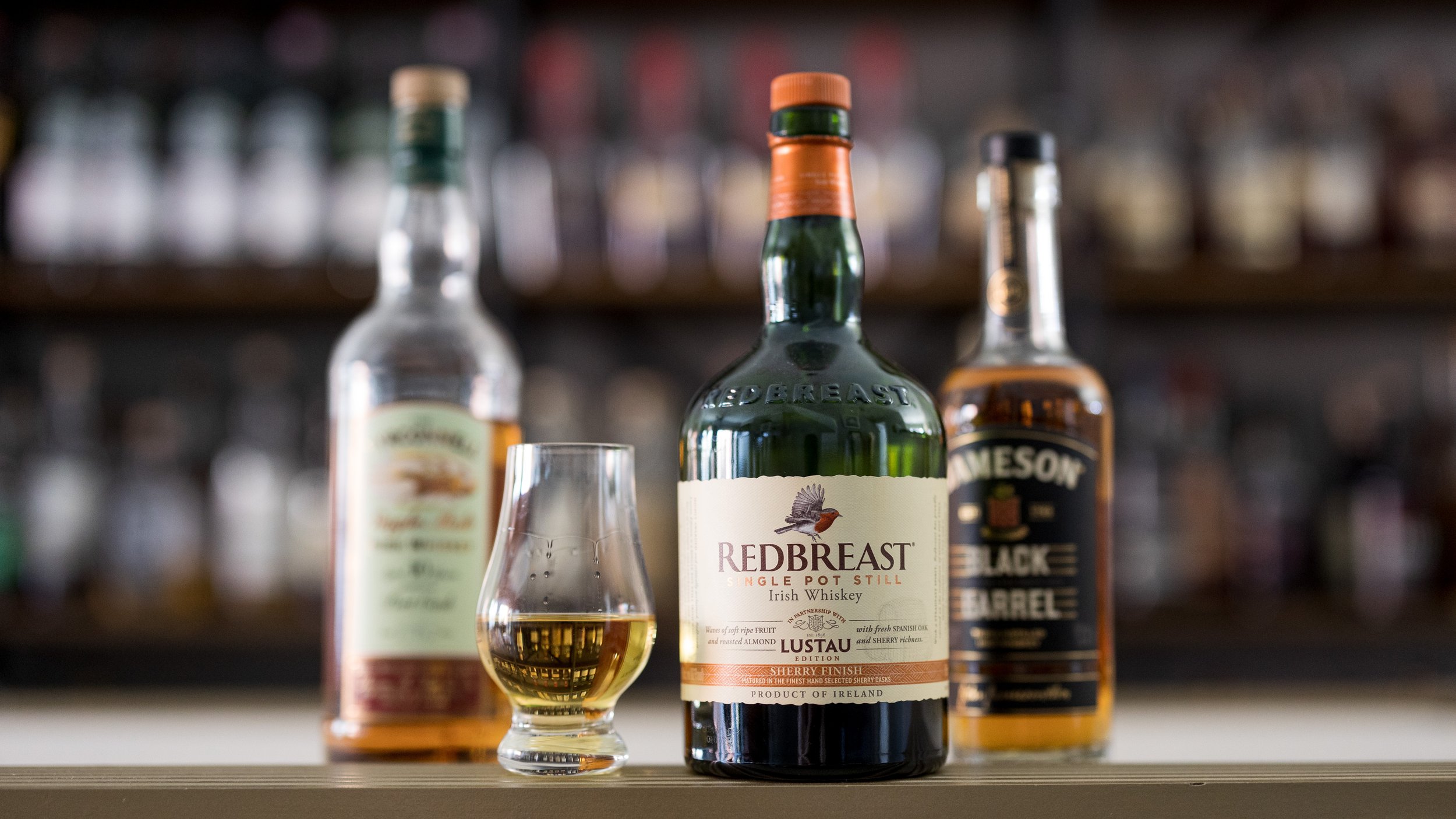A Look at Irish Single Pot Still Whiskey
In honor of St. Patrick’s Day, we’re breaking down one of our favorites: Irish single pot still whiskey. What do we love about it, and what differentiates it from other whiskeys? There are four different categories of Irish whiskey: single malt, single grain, blended, and single pot still. Of these, Irish single pot still whiskey is the only one that is only produced in Ireland.
What do we love about this unique style of whiskey?
When drinking single pot still whiskey, you might notice a creamy mouthfeel, a bit of spiciness, and a distinct cereal note not present in other whiskeys. That’s because this whiskey uses an unmalted barley (more on that in a moment) component that allows for these characteristics to shine through—which differentiates it from any other style of whiskey on the market.
You might also sense that this style of whiskey is a bit mellower and more easy drinking. This is because Irish single pot still whiskey is triple distilled, meaning more of the rough edges are rounded off during its additional pass through the pot still. Together, these two factors give pot still whiskey a truly unique style that resonates with many whiskey drinkers.
Irish whiskey: Whiskey from Ireland?
At the most basic level, all whiskeys are spirits distilled from fermented grains, and are made in almost every corner of the world. However, one of the most common descriptors of whiskey comes from where it is made: Scotch, Irish, bourbon, and Japanese are all place-based descriptors.
Often, similar to wine appellation, these place-based descriptors have legal requirements attached to them, as well: Irish whiskey is whiskey distilled and matured in Ireland; Scotch whisky is distilled, aged, and bottled in Scotland; and bourbon is a uniquely American whiskey that also must meet several other legal requirements.
Mash bill: What grains is the whiskey made from?
Another common set of descriptors for whiskey stems from the recipe of grains that the whiskey is made from, referred to as the “mash bill.” Common grains in a whiskey mash bill include malted barley, corn, rye, and wheat, though technically, a whiskey can be made from any cereal grain or grains—even uncommon ones like quinoa.
How does that play into common description terms? If you hear single malt, think 100% malted barley. If you hear bourbon, think at least 51% corn (along with some other requirements, which we’ll save for another post.)
Malted barley is a component in just about every style of whiskey because, when malted, barley releases an enzyme called amylase that, when mixed with hot water, converts the starches of the barley (and any other grains in the mash) into sugars, which are then converted into alcohol with the addition of yeast.
Irish single pot still whiskey uses a mash bill containing both malted and unmalted barley, each of which must make up at least 30% of the total mash bill. There can also be up to 5% of those other unmalted cereal grains—such as wheat, corn, rye, etc.
Pot stills and the history of Irish whiskey
Besides location and mash bill, another common descriptor for whiskey specifies the type of distilling equipment, or still, is used to produce the whiskey. Irish single pot still whiskey, as the name suggests, is made using the pot still, which distills in batches, versus the column still, which can distill continuously.
The origins of Irish pot still whiskey go back over two centuries, stemming from something that so often causes people to find creative solutions: taxes. In 1785, a tax on malted barley was introduced in Ireland. To avoid that tax, distilleries in Ireland started adding unmalted barley to their mash bill alongside the malted barley, and thus Irish pot still whiskey was born.
Over the next century, Irish pot still whiskey, made with a combination of malted and unmalted barley, was the most popular style of whiskey in the world due to its availability and drinkability.
In 1835, there were 93 licensed distilleries in Ireland, making mostly pot still whiskey. During this same decade, an invention came on the scene that would portend the near-demise of Irish single pot still whiskey. Aeneas Coffey, an Irishman, patented his eponymous Coffey still, an early version of today’s column still, which distilled whiskey continuously, as opposed to in batches as required in a pot still.
Coffey’s Irish countrymen were not interested in his creation, as pot still whiskey remained the dominant style of whiskey worldwide, with no signs of slowing. However, the Coffey still did find a home across the Irish Sea in Scotland—and would eventually help give rise to blended Scotch (which is a combination of 100% malted barley whisky distilled in a pot still, blended together with column-distilled whisky made of a variety of grains).
At the turn of the twentieth century, Irish whiskey as a whole, and Irish single pot still whiskey specifically, maintained a strong share of the worldwide whiskey market, but two events would deal blows to the style’s popularity.
First, the emergence of prohibition in America in 1919, and then, the Anglo-Irish trade war of the 1930s, cut off two of Ireland’s major export markets for pot still whiskey. In turn, bourbon (an American style) and blended Scotch grew in popularity and market share, pushing Irish whiskey to the margins.
By the 1960s, only three Irish distilleries remained in operation. By the 1980s, only one single pot still whiskey remained on the market: Green Spot. Fortunately, over the last 30 years, with the help of mergers providing access to global markets, along with an overall whiskey boom, the style has regained its foothold and there are now abundant offerings to choose from.
Recommendations for exploring Irish pot still whiskey
If you’re looking to explore this style, but don’t know where to start, we suggest taking a close look at the Midleton Distillery in Cork, Ireland. Midleton is home to some of the biggest brands in Irish whiskey, including Jameson (a blended Irish that includes pot still whiskey). It is also home to a number of Irish single pot still whiskeys including Redbreast, all of the various Spot whiskeys (including Green Spot), and a line of rare Midleton whiskeys perfect for collectors and those looking to splurge. Each of these whiskeys have their own unique characteristics resulting from varying times in the cask and from the types of casks used to mature each whiskey.
However, these are just a few of the ever-growing range of single pot still whiskeys that are now being produced by distilleries around Ireland. This St. Patrick’s Day, we hope you will celebrate with a dram of Irish whiskey and plan to continue your exploration of Ireland’s native whiskey throughout the year. Sláinte!

